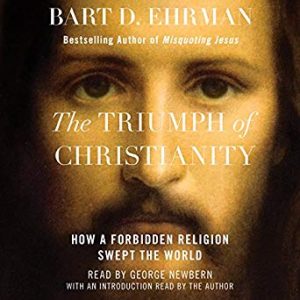 I am NOT going to tell you what or how to believe…
I am NOT going to tell you what or how to believe…
However, I’m reading a fascinating and quite controversial book. It’s from historian and ex-Evangelical Christian Bart D. Ehrman. And it analyzes the history of early Christianity, and its rise to being the dominant religion of the Roman Empire and then the West.
The book is called The Triumph of Christianity.
It chronicles the first four centuries of Christianity. And speaks with marvel at one very interesting and seemingly “miraculous” fact.
In the year 300, there were about 3 million Christians in the Roman Empire. By 400, there were 30 million. It’d grown from roughly 5% of the empire to 50%.
Now, there are all sorts of explanations folks have given through time. Constantine’s conversion. The spiritual superiority of Christianity. God’s will. The spiritual bankruptcy of the paganism it replaced. And so on.
While you may or may not agree with any of those assertions (I won’t comment on their validity here), Ehrman pointed to two very interesting things that distinguished Christianity. And set up its ascendancy and eventual overtaking of the other spiritual traditions of its time.
Both — in their day — were unique to Christianity, Ehrman argues, with the best history available to us today. And both created a simple mathematical path to dominance of Christianity.
Side note: I find people who are in marketing and only pay attention to and learn from marketing to be incredibly boring and limited in their effectiveness. I know this is a business and persuasion newsletter, and you may think, “Christianity, Roy, What?!” But if you divorce any personal views you may have in favor of or against Christianity and simply consider it as a highly-effective mass movement, you may find it easier to interpret and apply its lessons. That said, let’s dive in…
Step 1 — Create exclusivity…
In marketing and selling, we may think of “exclusive offers” as being something that helps with getting the sale.
And that’s true.
Oftentimes offering something in an exclusive way or through exclusive packaging — or being altogether unique and exclusive — can help create conversions.
But in the Roman empire, Christianity was unique in another kind of exclusivity.
While a small Jewish minority had long taught that in order to be a good Jew, you had to believe in their God as the one and only, most Romans had a different view of gods. There were practically unlimited gods. And worshiping one didn’t mean you had to ditch the others. In fact, it was rather rare for anyone in the Roman empire to believe in only one god. And to choose to worship one god simply meant you added them to your collection.
Christianity, on the other hand, taught that there was only one God, and to worship the Christian God, you had to reject every other god.
This meant that for every other god, there was simply “addition.” Whereas the entire concept of religious conversion really started in earnest with Christianity.
Every time Christianity got another member, all other sects and groups (and gods) lost one. Aside from the relatively small Jewish community, this was unique to Christianity.
So why did Christianity grow so much faster than Judaism?
For that, we look to the second factor…
Step 2 — Evangelize…
This didn’t happen in the way we think of now. The actual accounts of door-to-door missionaries are exceedingly rare, so much so that they are a non-factor in the greater spread of early Christianity.
However, Christians from the time of Paul taught that in order to be saved, you had to accept Christ. Otherwise, you faced eternal damnation.
Plus, Christianity taught to “Love your neighbor as yourself.” So it was your job as a Christian to not only ensure your personal salvation through conversion to Christianity, but to also ensure the salvation of others.
This easily extended to families. Often one family member (most often the patriarch) would convert, and bring their entire family with them. But it also extended to slaves and servants. Then business associates. Actual neighbors. And others throughout their community.
And it didn’t have to happen fast. For the math to work out — for Christianity to go from a couple dozen followers around the year 33 to 30 million in the year 400 — it took tiny numbers every year. For every 100 Christians, adding 3 to 5 to the group every year was all it took.
It was the magic of exponential growth, through evangelism. Like making a few percent returns on your money over decades will eventually make you rich, growing a small fringe movement a few members at a time will take over an entire empire within a couple century.
And of course, because conversion meant you were rejecting all other Gods, when you accepted Christ the classical Roman gods were rejected as false idols.
What to take from this?
There are a few lessons, I’m sure. About business and persuasion. As well as about life and humanity. You must discover your own.
I don’t wish to have a theological debate here.
Rather to point out that in the nature of moving people toward your cause, you can be helped by sometimes unexpected (and seemingly mundane) powers.
In hindsight, these seem clear and obvious ways to distinguish why Christianity would grow so fast, and overtake other forms of worship in the culture in which it grew.
However, at the time, they were NOT its main emphasis, and certainly were not given as justification for helping it grow.
And yet, that’s exactly what happened.
Yours for bigger breakthroughs,
Roy Furr



